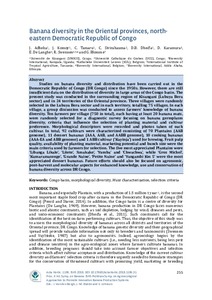| dc.contributor.author | Adheka, J. |
| dc.contributor.author | Komoy, J. |
| dc.contributor.author | Tamaru, C. |
| dc.contributor.author | Sivirahauma, C. |
| dc.contributor.author | Dhed'a, D.B. |
| dc.contributor.author | Karamura, D. |
| dc.contributor.author | Langhe, E. de |
| dc.contributor.author | Swennen, R. |
| dc.contributor.author | Blomme, Guy |
| dc.date.accessioned | 2019-12-04T11:21:39Z |
| dc.date.available | 2019-12-04T11:21:39Z |
| dc.date.issued | 2018 |
| dc.identifier.citation | Adheka, J., Komoy, J., Tamaru, C., Sivirahauma, C., Dhed'a, D.B., Karamura, D., ... & Blomme, G. (2018). Banana diversity in the Oriental provinces, north-eastern Democratic Republic of Congo. Acta Horticulturae, 1196, 255-264. |
| dc.identifier.issn | 0567-7572 |
| dc.identifier.uri | https://hdl.handle.net/20.500.12478/3842 |
| dc.description.abstract | Studies on banana diversity and distribution have been carried out in the Democratic Republic of Congo (DR Congo) since the 1950s. However, there are still insufficient data on the distribution of diversity in large areas of the Congo basin. The present study was conducted in the surrounding region of Kisangani (Lubuya Bera sector) and in 24 territories of the Oriental province. Three villages were randomly selected in the Lubuya Bera sector and in each territory, totalling 75 villages. In each village, a group discussion was conducted to assess farmers' knowledge of banana diversity. Ten farmers per village (750 in total), each having at least 20 banana mats, were randomly selected for a diagnostic survey focusing on banana germplasm diversity, criteria that influence the selection of planting material and cultivar preference. Morphological descriptors were recorded and photos taken of each cultivar. In total, 92 cultivars were characterized consisting of 70 Plantains (AAB genome), 11 dessert bananas (AAA, AAB, and AABB genome), 10 cooking bananas (AAA-EA and ABB genome) and 1 ABB cultivar ('Kayinja') used for brewing. Fruit pulp quality, availability of planting material, marketing potential and bunch size were the main criteria used by farmers for selection. The five most appreciated Plantains were 'Libanga Likale', 'Litete', 'Amakake', 'Yumba' and 'Chwachwa', while 'Gros Michel', 'Kamaramasenge', 'Grande Naine', 'Petite Naine' and LSQUOYangambi Km 5' were the most appreciated dessert bananas. Future efforts should also be focused on agronomic, post-harvest and molecular aspects for enhanced knowledge, use and conservation of banana diversity across DR Congo. |
| dc.format.extent | 255-264 |
| dc.language.iso | en |
| dc.subject | Morphology |
| dc.subject | Musa |
| dc.subject | Bananas |
| dc.subject | Democratic Republic Of Congo |
| dc.subject | Cooking Bananas |
| dc.subject | Germplasm |
| dc.subject | Cultivars |
| dc.subject | Diversity |
| dc.title | Banana diversity in the Oriental provinces, northeastern Democratic Republic of Congo |
| dc.type | Journal Article |
| dc.description.version | Peer Review |
| cg.contributor.crp | Roots, Tubers and Bananas |
| cg.contributor.affiliation | Université de Kisangani |
| cg.contributor.affiliation | Université Catholique du Graben |
| cg.contributor.affiliation | Bioversity International |
| cg.contributor.affiliation | Katholieke Universiteit Leuven |
| cg.contributor.affiliation | International Institute of Tropical Agriculture |
| cg.coverage.region | Africa |
| cg.coverage.region | Central Africa |
| cg.coverage.country | Congo, Dr |
| cg.creator.identifier | Rony Swennen: 0000-0002-5258-9043 |
| cg.researchtheme | BIOTECH & PLANT BREEDING |
| cg.authorship.types | CGIAR and developing country institute |
| cg.iitasubject | Banana |
| cg.iitasubject | Genetic Improvement |
| cg.iitasubject | Plant Breeding |
| cg.iitasubject | Plant Genetic Resources |
| cg.journal | Acta Horticulturae |
| cg.howpublished | Formally Published |
| cg.accessibilitystatus | Limited Access |
| local.dspaceid | 96108 |
| cg.targetaudience | Scientists |
| cg.identifier.doi | http://dx.doi.org/10.17660/actahortic.2018.1196.31 |

